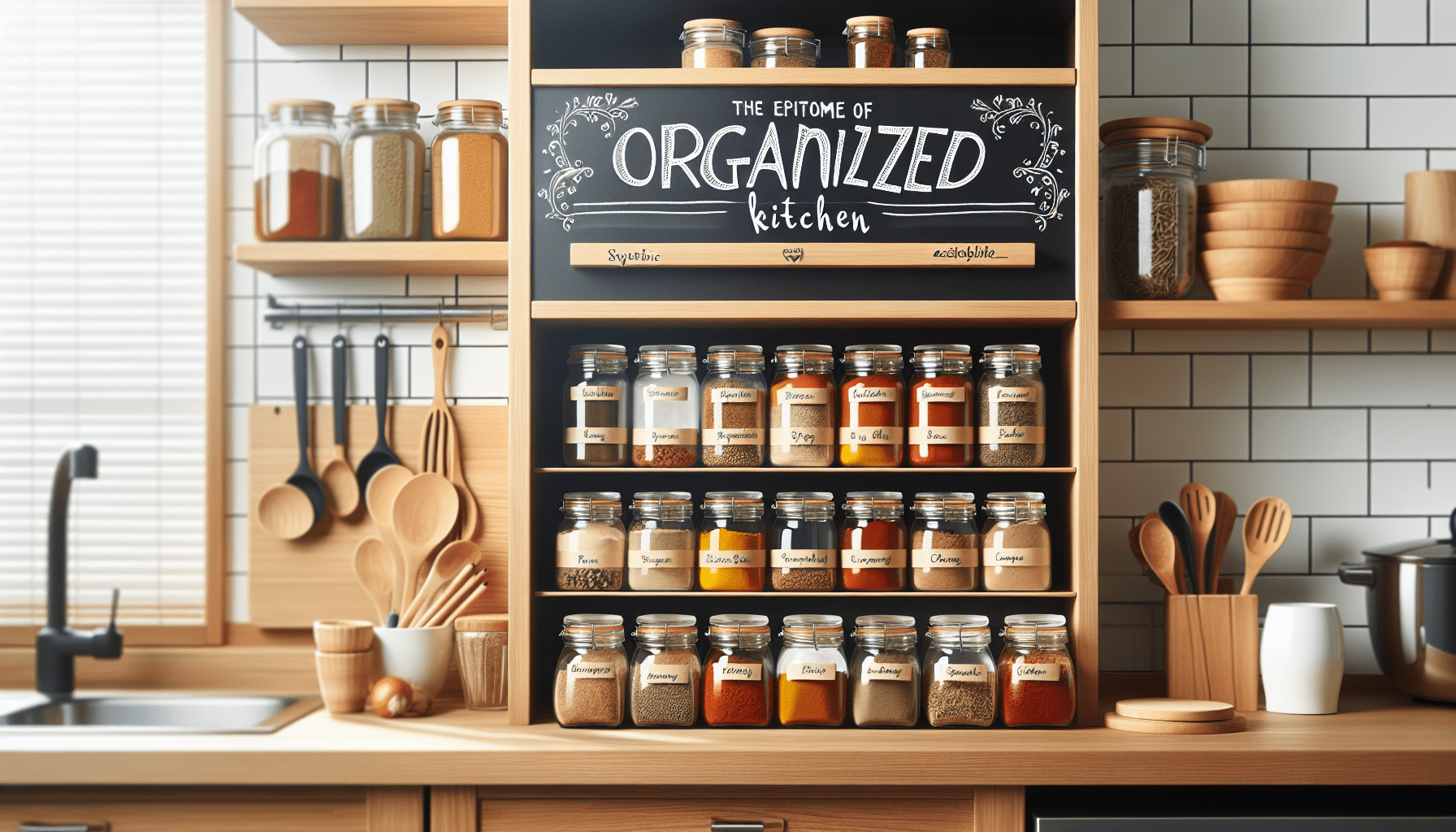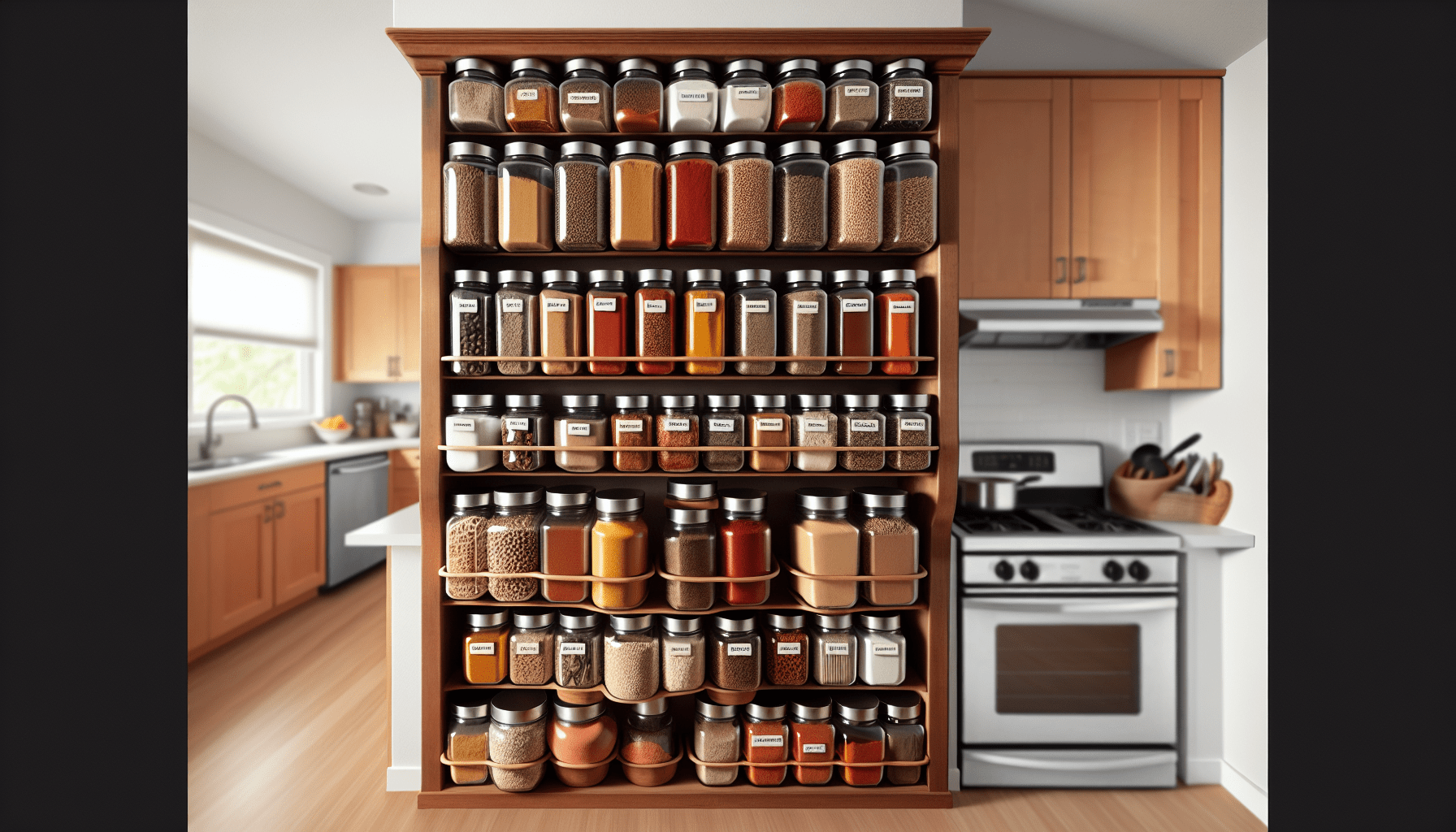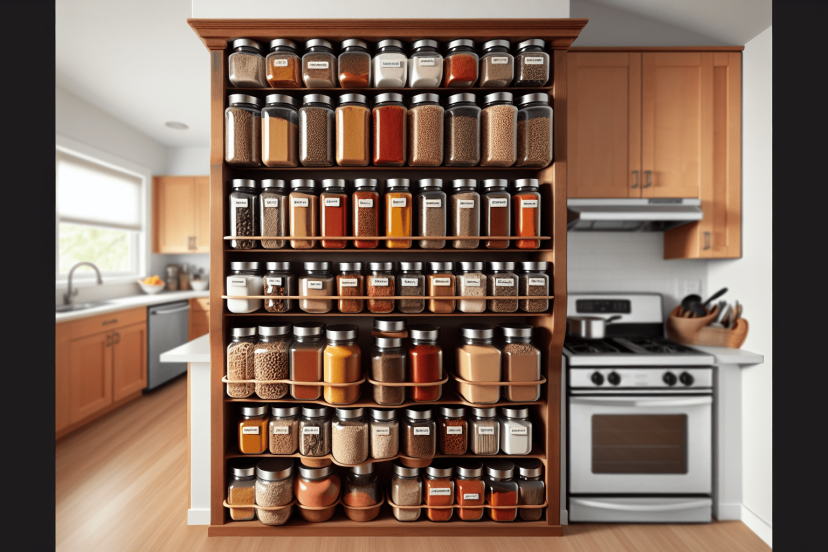How Do I Decide Where To Put Things In My Kitchen?
Arranging your kitchen can be a daunting task, but fear not! In this article, we will guide you through the process of deciding where to put things in your kitchen. From utensils to pots and pans, we will offer practical tips and suggestions to help you maximize your kitchen’s efficiency and create a well-organized space that suits your needs. Let’s embark on this culinary adventure together and transform your kitchen into a functional and inviting haven.

Consider the Workflow
Identify the primary activities in your kitchen
When it comes to organizing your kitchen, it’s important to consider how you use the space on a daily basis. Take a moment to think about the primary activities that happen in your kitchen. Are you mainly cooking, baking, or both? Do you also use your kitchen for meal prep or entertaining? By identifying these activities, you can better understand the flow of movement in your kitchen and determine the most efficient placement of items.
Analyze the flow of movement
Once you have identified the primary activities in your kitchen, it’s time to analyze the flow of movement. Consider how you move around the space when preparing meals or completing other tasks. You want to ensure that your kitchen is designed in a way that allows for easy navigation and minimizes any unnecessary steps. Think about the natural progression of tasks from one area to another and arrange your kitchen accordingly.
Arrange items based on frequency of use
To optimize your kitchen workflow, it’s important to arrange items based on their frequency of use. Keep frequently used items within reach, whether that’s on countertops or in easily accessible cabinets. By organizing your kitchen in this way, you’ll save time and effort when searching for the items you use most often. Less frequently used items can be stored in higher or lower cabinets, utilizing vertical space effectively.
Group Similar Items
Categorize your kitchen items
Categorizing your kitchen items is a simple yet effective way to keep things organized. Start by grouping items by type, such as baking supplies, cooking utensils, or dinnerware. This will make it easier to find what you need when you need it. Consider using clear plastic bins or storage containers to keep each category together, making it visually clear where everything belongs.
Place similar items together
Once you have categorized your kitchen items, it’s important to place similar items together. For example, store all your baking supplies in one cabinet or drawer, and keep all your cooking utensils in another. This not only helps with organization but also makes it quicker and easier to find what you need. You won’t waste time rummaging through different areas of your kitchen to locate specific items.
Allocate specific storage areas for each category
To maintain an organized kitchen, allocate specific storage areas for each category of items. This ensures that everything has a designated place, making it easier to put things away after use. Consider using drawer dividers or adjustable shelves to customize your storage spaces based on the size and quantity of items in each category. This will help maximize the efficiency of your kitchen layout.
Think Ergonomically
Consider the height of your shelving
When organizing your kitchen, it’s important to consider the height of your shelving. Keep frequently used items at arm’s reach, storing them on shelves that are easy to access without straining or bending. This applies to both upper and lower cabinets. By placing items at a comfortable height, you’ll reduce the risk of accidents and make your kitchen more ergonomic.
Place frequently used items at arm’s reach
In addition to considering the height of your shelving, it’s crucial to place frequently used items at arm’s reach. Store your everyday dishes, utensils, and cooking appliances in easily accessible cabinets and drawers, preferably in the areas closest to your main workstations. This will save you time and effort when preparing meals and cooking, ensuring a smooth workflow in your kitchen.
Store heavy items at waist level
When it comes to organizing your kitchen, it’s important to consider the weight and size of items. Store heavy items, such as pots and pans, at waist level. This will minimize the strain on your back when lifting and prevent the risk of items toppling or falling. Keeping heavier items within easy reach will also eliminate the need to bend down or stretch to retrieve them.
Utilize Storage Solutions
Maximize cabinet space
To make the most of your kitchen storage, it’s essential to maximize cabinet space. Use stackable storage containers or shelf risers to create additional levels within your cabinets. This allows you to utilize the vertical space and creates more room for storing items. Consider investing in adjustable shelves or pull-out organizers to customize your cabinets based on your specific needs.
Install hooks and racks for utensils
One way to free up cabinet space and keep your kitchen organized is by installing hooks and racks for utensils. Hang pots and pans on a wall-mounted rack to free up valuable cabinet space. Use hooks inside cabinet doors to hang measuring spoons, oven mitts, or dish towels. By utilizing these storage solutions, you’ll have easy access to your utensils while maximizing your available space.
Organize spices and condiments in a designated area
Spices and condiments can quickly clutter up your kitchen if not properly organized. Create a designated area for these items, such as a spice rack or a pull-out drawer. Arrange them in alphabetical order or by type to make it easy to find what you need. Consider using clear containers or labels to further streamline the organization of your spices and condiments.

Create Zones
Identify different functional areas in your kitchen
To create an efficient and organized kitchen, it’s important to identify different functional areas. Common areas include the prep area, cooking area, and cleaning area. By recognizing these zones, you can assign specific activities to each space and ensure that the necessary tools and ingredients are easily accessible in each area.
Designate zones for prepping, cooking, and cleaning
Once you have identified the different functional areas in your kitchen, it’s crucial to designate zones for prepping, cooking, and cleaning. Keep all your cutting boards, knives, and other prep tools near the prep area. Store pots, pans, and cooking utensils in the cooking area, and keep cleaning supplies and tools near the cleaning area. This way, everything you need for each task is readily available in the appropriate zone.
Allocate storage based on each zone’s requirements
To create an organized kitchen with seamless workflow, allocate storage based on each zone’s requirements. For example, keep mixing bowls and measuring cups near the prep area, and store cooking oils and spices close to the cooking area. Consider installing pull-out drawers or shelves near the sink for easy access to cleaning supplies. By aligning your storage with each zone, you’ll optimize efficiency and simplify your kitchen routine.
Prioritize Safety
Store sharp objects in a secure location
When organizing your kitchen, it’s crucial to prioritize safety, especially when it comes to storing sharp objects. Keep knives, scissors, and other sharp tools in a secure location, such as a knife block or a dedicated drawer with a childproof lock. This prevents accidents and ensures that these items are out of reach of children or anyone who may accidentally come into contact with them.
Keep hazardous items out of reach of children
In addition to storing sharp objects securely, it’s important to keep all hazardous items out of reach of children. This includes cleaning supplies, chemicals, and potentially toxic substances. Store these items in locked cabinets or high shelves to prevent accidental ingestion or exposure. It’s also a good idea to use childproof locks on cabinet doors to further enhance safety in your kitchen.
Ensure easy access to fire extinguishers and first aid kits
As part of kitchen safety, it’s essential to ensure easy access to fire extinguishers and first aid kits. Install a fire extinguisher in a visible and easily accessible location, such as near the exit of your kitchen. Keep a well-stocked first aid kit in a designated area, ensuring that it contains essential items like bandages, antiseptic, and burn ointment. By having these safety measures in place, you can quickly respond to emergencies and minimize the potential for injuries.
Consider Accessibility
Designate a space for pet food and supplies
If you have pets, it’s important to designate a specific space for their food and supplies. Create a pet-friendly zone in your kitchen and store their food, treats, and bowls in an accessible location. Consider using airtight containers to keep pet food fresh and to prevent any unwanted pests. By having a dedicated area for your furry friends, you’ll simplify feeding time and ensure their supplies are always within reach.
Ensure accessibility for individuals with disabilities
Inclusivity in kitchen organization is crucial. Consider the needs of individuals with disabilities when arranging your kitchen. Ensure that countertops and workstations are at an appropriate height for wheelchair users. Install pull-out shelves or lazy susans to allow easy access to items in lower cabinets. By making your kitchen accessible, you create a welcoming environment for everyone to enjoy and participate in daily activities.
Consider the reach and mobility of all kitchen users
Accessibility is not only important for individuals with disabilities but for all kitchen users. Consider the reach and mobility of everyone who uses the kitchen space, taking into account varying heights and abilities. Keep items that are frequently used within reach of the shortest individual to avoid straining or climbing. By considering the needs of all users, you create a kitchen that is functional and accommodating for everyone.
Account for Kitchen Size
Optimize storage in a small kitchen
If you have a small kitchen, optimizing storage becomes even more crucial. Every inch of space counts, so make use of vertical storage options such as wall-mounted shelves or hanging pot racks. Install shelves or pegboards on the inside of cabinet doors to maximize storage potential. Consider utilizing stackable storage containers or drawer dividers to maximize space within cabinets and drawers. With some creative thinking, you can make the most of your small kitchen and keep it organized.
Utilize vertical space for additional storage
In any kitchen, whether big or small, utilizing vertical space is a great way to create additional storage. Install shelves or racks on walls for storing pots, pans, or other commonly used items. Consider using magnetic knife strips or hooks for hanging utensils or cooking tools. By taking advantage of the vertical space, you can keep your countertops clear and create a more organized and functional kitchen.
Avoid overcrowding in a compact kitchen
While it’s important to maximize storage in a small kitchen, it’s equally crucial to avoid overcrowding. Be strategic in choosing which items to keep and only keep what you truly need. Avoid overfilling cabinets or overcrowding countertops, as this can make your kitchen feel cluttered and diminish its functionality. Being mindful of the available space and keeping only essential items will help maintain an organized and efficient kitchen environment.
Maintain a Functional Layout
Ensure clear pathways between workstations
To maintain a functional kitchen layout, it’s important to ensure clear pathways between workstations. Arrange your countertops and appliances so there is ample space to move freely between them. Avoid placing items or furniture in the way of these pathways, as this can impede movement and make your kitchen feel cramped. By creating clear pathways, you’ll have a smoother workflow and a safer kitchen environment.
Avoid placing obstacles in high-traffic areas
When organizing your kitchen, be mindful of high-traffic areas and avoid placing any unnecessary obstacles in these locations. For example, ensure that cabinet doors or drawers don’t block the flow of movement in busy areas. Keep countertops clear of clutter, allowing for smooth transitions between different tasks. By maintaining clear, obstacle-free areas, you’ll be able to navigate your kitchen more efficiently and minimize the risk of accidents.
Allow ample space for opening appliances and cabinets
As part of maintaining a functional layout, it’s important to allow ample space for opening appliances and cabinets. Consider the swing of refrigerator and oven doors, and ensure that there is enough room to fully open them without obstructing nearby countertops or workstations. Allow enough clearance for cabinet doors to fully open without hitting nearby items. By giving appliances and cabinets the space they need, you’ll maintain a functional and user-friendly kitchen.
Consider Aesthetic Appeal
Choose a cohesive color scheme
In addition to functionality, the aesthetic appeal of your kitchen is also important. Choose a cohesive color scheme that reflects your personal style and complements the overall design of your home. Opt for colors that create a sense of harmony and make the space feel inviting. By selecting a cohesive color scheme, you’ll create a visually pleasing kitchen that you’ll enjoy spending time in.
Organize items based on visual appeal
When organizing your kitchen, it’s not just about functionality but also about visual appeal. Organize items based on their visual appeal, placing decorative and frequently used items in prominent positions. Consider displaying colorful cookware or stylish containers on open shelves or countertops. By incorporating visually appealing elements, you’ll create a kitchen that is both functional and visually pleasing.
Display decorative and frequently used items
As mentioned earlier, displaying decorative and frequently used items can enhance both the functionality and aesthetics of your kitchen. Utilize open shelves or glass-front cabinets to showcase decorative bowls, plates, or glasses. Hang attractive pots and pans on a wall-mounted rack as a decorative element. By integrating decorative and frequently used items into your kitchen design, you’ll add personality and style to the space.
In conclusion, organizing your kitchen requires careful consideration of workflow, grouping similar items, thinking ergonomically, utilizing storage solutions, creating zones, prioritizing safety, considering accessibility, accounting for kitchen size, maintaining a functional layout, and considering aesthetic appeal. By following these guidelines, you can create a well-organized and efficient kitchen that meets your needs and reflects your personal style. Happy organizing!




